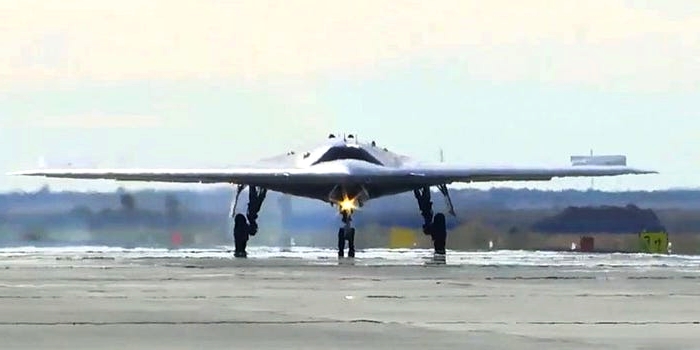
According to Russian and American sources, Russia unveiled the second prototype of its long awaited stealth attack drone S-70 Okhotnik, at the Novosibirsk Aviation Production Association, (NAPO).
Compared to its predecessor, the second prototype of the S-70 Okhotnik appears to have made significant progress.
The attack stealth drone features a sleek nozzle configuration and a redesigned engine exhaust system.
So far, it is unclear whether it is fitted with a new engine. The first prototype was powered by an AL-41F engine, the same engine that powers Russia’s multi-role Su-35 Flanker. This engine also powers its first mass-produced stealth fighter C-57 Felon.
The first and the second prototype show a clean design. The second prototype shows an unusual pair of air intakes at the top of the main intake, the purpose of which is unclear, although it is not uncommon for a concealed aircraft to have such characteristics.
According to a report from a US publication, The Drive, while the second prototype has yet to be painted with the usual “pixel” camouflage, there is a noticeable processing of the wings, which involves the application of radio-absorbing material.
The first prototype was unveiled around two years ago and was unveiled at the MAX aviation exhibition in 2019.
Since then, according to media reports, the first prototype has undergone several tests, including combat tests using air-to-air missiles. The drone is said to have been fitted with dummy missiles. It is unclear whether any live missile were launched from it.
Clearly Moscow has high expectations from the S-70 Okhotnik.
“The roll-out of the UAV marks the completion of the assembly of the product as a whole, equipping it with all the necessary onboard equipment by the requirements for the aircraft, and the transition to complex ground tests to prepare for the first flight,” said Russian Deputy Minister of Defense Alexei Krivoruchko.
According to Thomas Newdick and Tyler Rogoway, the authors of the article in The Drive, the second prototype shows significant improvements in terms of engineering and technology, including stealth technology.
They are quick to remind us that this prototype has yet to complete several rounds of tests, both on the ground and in the air, where its systems will be tested.
“Technologies tested on the prototypes will be used in the creation of other promising aircraft systems – both manned and unmanned,” said Krivoruchko while hinting that the results after its testing could be implemented in Russia’s new strategic bomber, PAK DA, which also sports a flying-wing design.
The Russians expects the S-70 to have a long flight time in the air and be able to deliver a significant amount of combat cargo.
Once it enters service, it is likely to break new grounds towards becoming a true low-observable combat aircraft.
The combat drone is likely to be offered for export to friendly countries.




